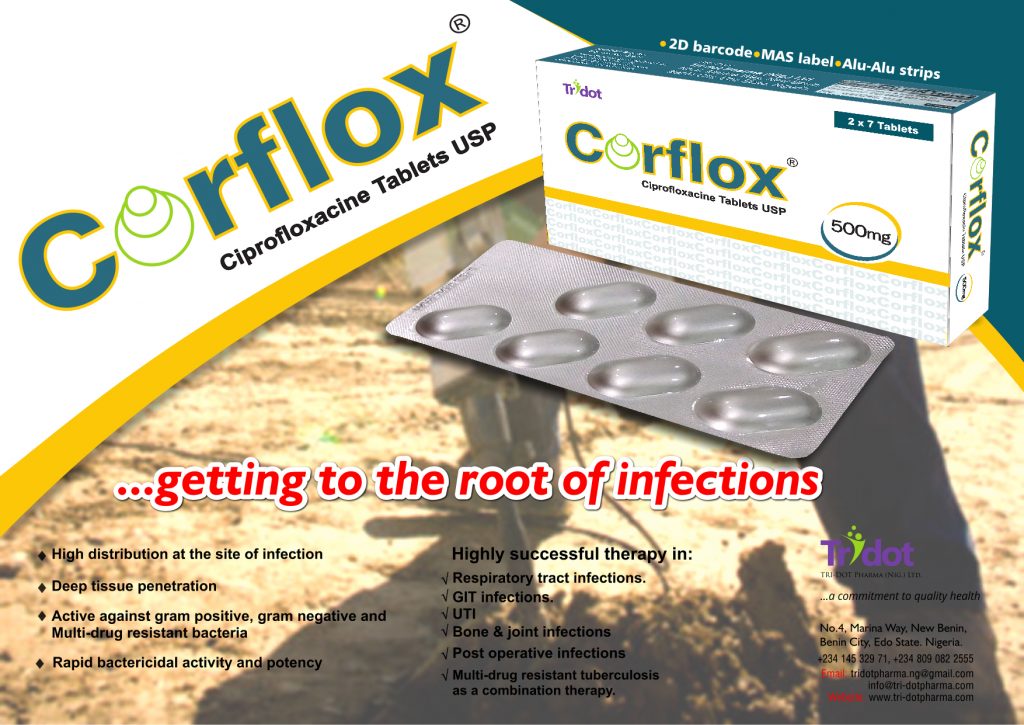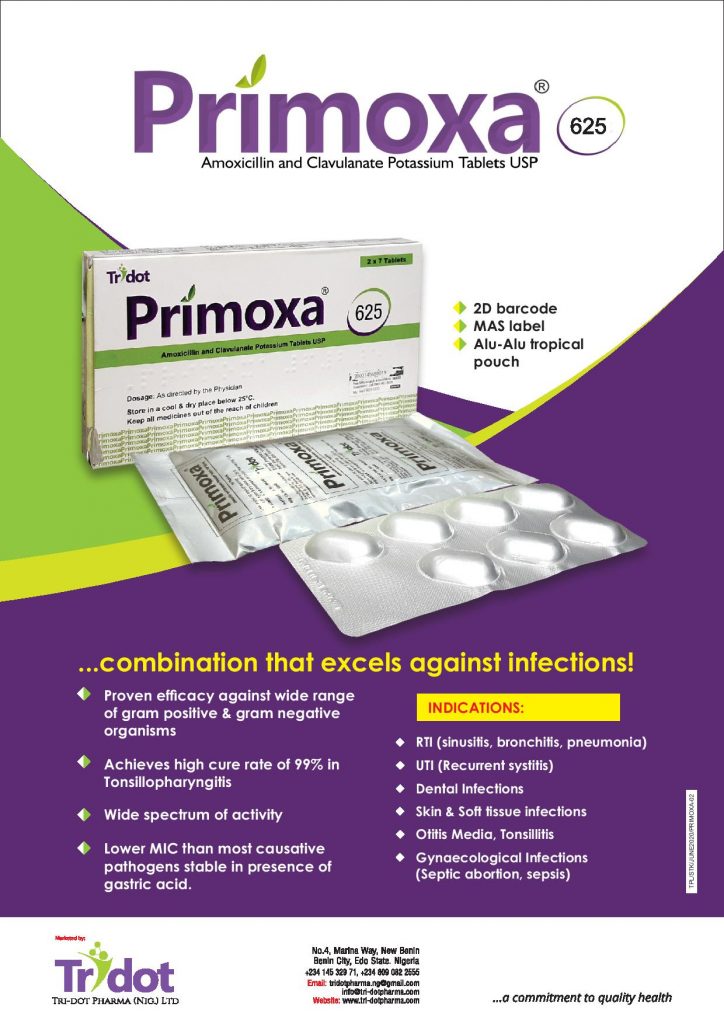Corflox®
(Ciprofloxacin Tablets U.S.P. 500 mg)
COMPOSITION:
Each film coated tablet contains: Ciprofloxacin Hydrochloride USP Eq. to Ciprofloxacin 500 mg, Excipients Q.S.
PHARMACOLOGY:
As a fluoroquinolone antibacterial agent, the bactericidal action of ciprofloxacin results from the inhibition of both type II topoisomerase (DNA-gyrase) and topoisomerase IV, required for bacterial DNA replication, transcription, repair and recombination.

Indications
It is effective in Lower Respiratory Tract infections due to Gram-negative bacteria, exacerbations of Chronic Obstructive Pulmonary Disease, Broncho-pulmonary infections in cystic fibrosis or in bronchiostasis, Pneumonia, chronic suppurative Otitis media, acute exacerbation of chronic sinusitis especially if these are caused by Gram-negative bacteria, Urinary Tract Infections, Gonococcal uretritis and cervicitis, Epididymo-orchitis including cases due to Neisseria gonorrhoeae, Pelvic Inflammatory Disease including cases due to Neisseria gonorrhoeae, in treatment of infections of the gastro-intestinal tract, Intra-abdominal infections, infections of the skin and soft tissue caused by Gram-negative bacteria, infections of the bones and joints, treatment of infections in neutropenic patients, and prophylaxis of infections in neutropenic patients.
Dosage and Administration
CORFLOX® Tablets should be administered orally to adults as described in the Dosage Guidelines table.
Contraindications
Hypersensitivity to the active substance, to other quinolones or to any of the excipients. Concomitant administration of ciprofloxacin and tizanidine.
Overdose
Symptoms
An overdose of 12 g has been reported to lead to mild symptoms of toxicity. An acute overdose of 16 g has been reported to cause acute renal failure.
Symptoms in overdose consist of dizziness, tremor, headache, tiredness, seizures, hallucinations, confusion, abdominal discomfort, renal and hepatic impairment as well as crystalluria and haematuria. Reversible renal toxicity has been reported.Treatment
Apart from routine emergency measures, e.g. ventricular emptying followed by medical carbon it is recommended to monitor renal function, including urinary pH and acidity, if required, to prevent crystalluria. Patients should be kept well hydrated.
Calcium or magnesium containing antacids may theoretically reduce the absorption of ciprofloxacin in overdoses
Only a small quantity of ciprofloxacin (<10%) is eliminated by haemodialysis or peritoneal dialysis.
In the event of overdose, symptomatic treatment should be implemented. ECG monitoring should be undertaken, because of the possibility of QT interval prolongation.Shelf-Life
36 Months
Storage and Handling Instructions
Store in cool & dry place, away from sunlight. Keep all medicines out of reach of children.
Packaging Information
2 X 7 Alu Alu Pack.
Primoxa®
(Amoxicillin & Clavulanate Potassium Tablets USP 625 mg)
COMPOSITION:
Each film coated tablet contains: Amoxicillin Trihydrate BP, Equivalent to Amoxicillin: 500 mg. Clavulanate Potassium USP Equivalent to Clavulanic acid: 125 mg. Excipients: Q.S.
PHARMACOLOGY
Pharmacodynamics
Pharmacotherapeutic group: Combinations of penicillins, including beta-lactamase inhibitors
Mode of action
Amoxicillin is a semisynthetic penicillin (beta-lactam antibiotic) that inhibits one or more enzymes (often referred to as penicillin-binding proteins, PBPs) in the biosynthetic pathway of bacterial peptidoglycan, which is an integral structural component of the bacterial cell wall. Inhibition of peptidoglycan synthesis leads to weakening of the cell wall, which is usually followed by cell lysis and death.
Amoxicillin is susceptible to degradation by beta-lactamases produced by resistant bacteria and therefore the spectrum of activity of amoxicillin alone does not include organisms which produce these enzymes.
Clavulanic acid is a beta-lactam structurally related to penicillins. It inactivates some beta-lactamase enzymes thereby preventing inactivation of amoxicillin. Clavulanic acid alone does not exert a clinically useful antibacterial effect.

Indication
PRIMOXA® 625 is indicated for the treatment of the following infections in adults and children:
- Acute bacterial sinusitis (adequately diagnosed)
- Acute otitis media
- Acute exacerbations of chronic bronchitis (adequately diagnosed)
- Community acquired pneumonia
- Cystitis
- Pyelonephritis
- Skin and soft tissue infections in particular cellulitis, animal bites, severe dental abscess with spreading cellulitis
- Bone and joint infections, in particular osteomyelitis.
Dosage and Administration
For Oral use
As directed by physician.
PRIMOXA® 625 may be taken without regard to meals; however, absorption of clavulanate potassium is enhanced when PRIMOXA® 625 is administered at the start of a meal. To minimize the potential for gastrointestinal intolerance, PRIMOXA® 625 should be taken at the start of a meal.Contraindications
Hypersensitivity to the active substances, to any of the penicillins or to any of the excipients.
History of a severe immediate hypersensitivity reaction (e.g. anaphylaxis) to another beta-lactam agent (e.g. a cephalosporin, carbapenem or monobactam).
History of jaundice/hepatic impairment due to amoxicillin/clavulanic acid.Warnings and Precautions
Before initiating therapy with amoxicillin/clavulanic acid, careful enquiry should be made concerning previous hypersensitivity reactions to penicillins, cephalosporins or other beta-lactam agents.
Serious and occasionally fatal hypersensitivity (anaphylactoid) reactions have been reported in patients on penicillin therapy. These reactions are more likely to occur in individuals with a history of penicillin hypersensitivity and in atopic individuals.Overdose
Symptoms and signs of overdose
Gastrointestinal symptoms and disturbance of the fluid and electrolyte balances may be evident. Amoxicillin crystalluria, in some cases leading to renal failure, has been observed.
Convulsions may occur in patients with impaired renal function or in those receiving high doses.
Amoxicillin has been reported to precipitate in bladder catheters, predominantly after intravenous administration of large doses. A regular check of patency should be maintained.Treatment of intoxication
Gastrointestinal symptoms may be treated symptomatically, with attention to the water/electrolyte balance.
Amoxicillin/clavulanic acid can be removed from the circulation by haemodialysis.Storage and Handling Instructions
Store in cool & dry place, away from sunlight. Keep all medicines out of reach of children.
Packaging Information
2 X 7 Alu Alu Pack.
